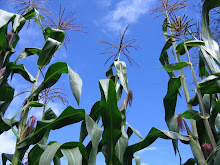Or perhaps this post should be titled: Why I Secretly Love When My Jams Don't Set
There was a huge storm two Thursdays ago. At the time, we really needed the rain, but no one needed the hail. All the lighting, hail and wind were too much for the power lines in the section of the Hudson Valley where I live and work for half of every week.
There's something to be said for living off-grid, for a number of reasons that I will not get into now, but this all becomes even more apparent when you've got no electricity and you realize you're entirely reliant on a big, faceless power company.
We lost power at the farm, while I was still working. The strawberries had ripened way too quickly for us to pick fast enough in the extreme heat, so we were hastily hulling them in order to freeze them for sale in the winter. Then the lights went out, and didn't come back on. The winds were so strong, and between that and the hail and lightning, we began making plans to get inside the walk-in cooler in case all that nasty weather turned into a tornado. Thankfully it didn't.
I went home with four quarts of strawberries, yet to be hulled, in order to make jam. I drove the 13 miles home from the farm, and along the way no one had power. When I got home the vegetable plants in my garden were laying down, in shock from the heavy rains, hail, and 25 degree temperature drop they'd just been through. There was debris scattered about from the trees, but other than that there didn't seem to be any damage. I decided to use what was left of the daylight to begin reading a new book, and put candles around the house. When, and only when it finally got dark out, did I begin hulling strawberries by candlelight at the dining room table. Two full days of hulling strawberries at the farm, and the most berry-hulling-fun I had was sitting by myself quietly, hulling those 4 quarts by candlelight.

Now, if you want to follow my recipe, but you also want your jam to set, I strongly suggest you halve the recipe below. If you want to take your chances (as I prefer) then just follow the recipe as is. My preserved strawberries are suspended in a syrup that just yearns to be poured over ice cream, yogurt, or just eaten by the spoonful. I can't get enough. It's delicious, and I don't miss the jam-that-would-have-been at all.
Happy Summer!
------------
Candlelight Preserved Strawberries
Quantities and techniques adapted from Put 'em Up! by Sherri Brooks Vinton, Canning for a New Generation by Liana Krisoff, and Mes Confitures by Christine Ferber.
Makes
roughly 4 pints
4 quarts strawberries (preferably no spray)
2 cups cane sugar
3 lemons
4 pint jars or 8 half pint jars (or any mix thereof)
*See note below for potential variations
Hull the strawberries leaving them whole if they are small, cutting them in half if they are large. Toss them in a large, non-reactive bowl or pot with the sugar, cover and allow to macerate in the fridge overnight, or until the next evening if you don't have time to make the preserves in the morning.
The next day, pull your strawberries out of the fridge (I refrigerated mine in the pot I was planning on cooking them in, which helped since I had no running water for clean-up the night before when there was no electricity). Juice the lemons, strain the juice if necessary, and set aside. Reserve the seeds from the lemons when juicing and place them in a dampened cheesecloth bag.
Clean your jars and lids, and prepare a pot of water for water bath canning. Here's
a bit of instruction on water bath canning if you are unfamiliar with the process. (In this circumstance it is not necessary to sterilize any of the equipment beforehand since the jars will be sealed in the boiling water for 10 minutes).
Add the cheesecloth bag to the pot of strawberries and bring it all to a boil. Add the lemon juice then continue boiling for about 20 minutes, or until desired set is reached. I do not recommend boiling for much more than 20 minutes or you risk the strawberries losing their vibrant, fresh flavor.
 |
| my canning rack is too big for this pot so I use a dish towel to keep the jars from rattling |
Once the preserves are ready ladle into clean jars, close up the jars and place them in the canning pot. Bring the water in the pot back to a boil, and let the jars process in the boiling water for 10 minutes. Remove jars and allow to rest undisturbed for 12 hours.
The preserves will keep, out of direct light, for at least a year. Once opened, the preserves will keep in the fridge for at least a month, unless you eat them first.
*If you want to play around and vary this recipe a bit, you can throw in a vanilla bean during cooking, lemon zest, or a drop of balsamic vinegar - each pair very well with strawberries!





















